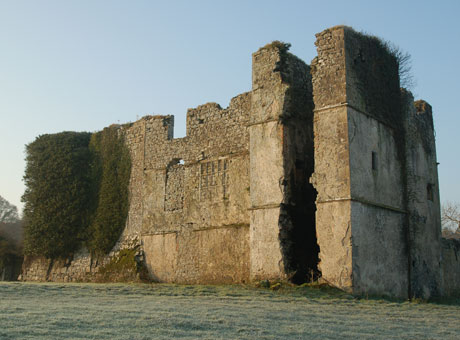
Rathcline Castle, situated 2km from the town of Lanesborough, overlooking Lough Ree, was built around the 9th Century by the O’Quinn clan. Later it was fought for and taken by the O’Farrell clan and subsequently taken over by the Normans around the beginning of the 12th Century.
In 1649, the Parlimentarian Oliver Cromwell defeated the King Charles I and the Royalists in the English Civil War and conquered Ireland and Scotland, ruling as Lord Protector from 1653 until his death in 1658. During this time the Catholic Norman decendants, occupying Rathcline were ousted from their lands. In 1664 George Lane was granted the manor and lands of Rathcline by King Charles II, after supporting him in the English Civil War and his restoration to the throne in 1660. George Lane was the son of Sir Richard Lane and was born in Tulsk, Co. Roscommon. After the restoration George’s portfolio of lands increased with grants of land in Leitrim, Roscommon, Dublin, Waterford and Longford. Lane set about restoring the Castle to its former glory and landscaping the grounds. In 1676, Lane was created 1st Viscount of Lanesborough. He continued with the development of the village of Lanesborough and the rebuilding of St. John’s Church in 1678. George Lane died in Lanesborough in 1683 and was laid to rest in the family vault under St. John’s Church. His son James became 2nd Viscount of Lanesborough inherited his fathers lands. 1690 saw the final chapter in the history of Rathcline Castle as a complete building as it was once again badly damaged in the Williamite/Jacobite War, after Willams army followed the retreating Jacobite forces, ruining both Rathcline Castle and St. John’s Church with cannon fire. The Castle was never rebuilt and James Lane left Lanesborough, settled in London and died in 1724. The lands of Rathcline passed to the family of his sister Francis Lane Fox and were eventually sold to Luke White around 1770.
Luke White also bought Luttrellstown House, which he renamed Woodlands, a house in Merrion Square in Dublin and Killakee Castle, Co. Dublin. He built Rathcline House a short distance from the Rathcline Castle ruins, but considered it too small and moved to England and died in 1824. He had 8 children, one of his sons, also called Luke, inherited Rathcline and was also MP for Longford, winning elections against Tory, Anthony le Froi of Carrickglass, Co. Longford. It was this Luke White that built a school (the Old Schoolhouse) in Tullyvrane a short distance away, for the parish in the 1830s and employed two teachers, a headmaster and mistress, to educate the local children. In the early part of the 20th Century Rathcline Castle and lands were sold to George Federick Geofferoy and on his death the estate was divided by the Irish Land Commission. In 1946 the ruins of Rathcline Castle and land north of the adjacent road were sold to Michael Farrell, a local farmer born in Lisnacusha (the Peer Inn), living in Lanesborough and was inherited by his daughter Kathleen Farrell and eventually sold to the Kearns family. In 1953 the Sisters of Mercy bought Rathcline House and 20 acres of surrounding land, south of the road and remained there until 1969, when it was sold to the Lyons family, followed by the Cunningham family and is now owned by the Kearns family.